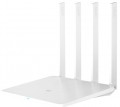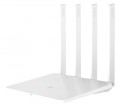Wireless speed 5 GHz
The maximum speed supported by the device when communicating wirelessly in the 5 GHz band.
This range is used in Wi-Fi 4, Wi-Fi 6 and Wi-Fi 6E as one of the available bands, in Wi-Fi 5 as the only one (see "Wi-Fi Standards"). The maximum speed is specified in the specifications in order to indicate the real capabilities of specific equipment - they can be noticeably more modest than the general capabilities of the standard. Also, in fact, it all depends on the generation of Wi-Fi. For example, devices with Wi-Fi 5 support can theoretically deliver up to 6928 Mbit (using eight antennas), with Wi-Fi 6 support up to 9607 Mbit (using the same eight spatial streams). The maximum possible communication speed is achieved under certain conditions, and not every model of Wi-Fi equipment fully satisfies them. Specific figures are conditionally divided into several groups: the value
up to 500 Mbit is rather modest, many devices support speeds in the range of
500 - 1000 Mbit, indicators of
1 - 2 Gbps can be attributed to the average, and the most advanced models in class provide a data exchange rate of
over 2 Gbps.
USB 3.2 gen1
The number
of USB 3.2 gen1 ports provided in the design of the device.
USB in this case plays the role of a universal interface for connecting peripheral devices to the router. The specific USB devices supported and how they are used may vary. Examples include working with a flash drive that plays the role of a drive for working in FTP or file server mode (see "Functions / Capabilities"), connecting to a printer in print server mode (see ibid), connecting a 3G modem (See "Data input (WAN-port)"), etc.
Specifically, the version of USB 3.2 gen1 (formerly known as USB 3.0 and USB 3.1 gen1) is the direct successor to USB 2.0, which, in particular, has increased by 10 times (up to 4.8 Gbps) the maximum data transfer rate and increased power supply. However despite the general popularity, this standard is still relatively rare in Wi-Fi devices — USB 2.0 is enough for many tasks. However, the situation is gradually changing; and among advanced hardware such as gaming routers, you can find solutions with
2 or more USB 3.2 gen1 ports.
MU-MIMO
Device support for
MU-MIMO technology - multi-user multi-threaded I / O.
Communication in multiple streams is implemented through the use of multiple antennas on both the transmitting and receiving device. This allows you to increase the bandwidth of the channel, as well as improve the overall quality and stability of the connection. And the term "multi-user" usually means that Wi-Fi equipment is able to simultaneously work with several external devices that support multi-streaming (MIMO). The only exceptions are Wi-Fi adapters (see "Device type") - they are more about the ability to interact with the router / access point as efficiently as possible, which also uses MU-MIMO.

